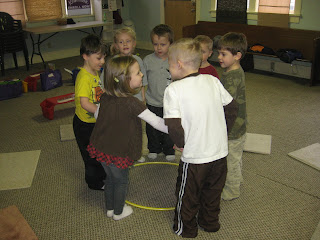What a relaxing calming way to start this week’s Village class—an intentional touch routine to the recording of “Little Boy Blue.” In the beginning of the semester some babies seemed uncomfortable relaxing in a strange place. But I am noticing a peaceful calm throughout the room when this activity begins.
Each Village lesson includes a Warm-up or an Intentional Touch Activity. In addition to being a way to create adult-baby emotional bonding, intentional touch has many physical benefits, including stimulation of the digestive, circulatory, and lymph systems.
Whether waking up from a nap or from a night’s sleep, an intentional touch routine with a rhyme or a song can make the transition from sleep a little easier. When your little one seems unusually fussy or irritated and can’t seem to calm down, a relaxing intentional touch routine may be what is needed.
 Our Time: Away We Go!
Our Time: Away We Go!Your toddler spends a lot of time working the big muscles she needs for walking and running. Equally important are the smaller muscles in her fingers, the fine motor skills.
We use these muscles when we’re “walking” fingers, shaking eggs, rolling hands, wiggling thumbs, playing the sandblocks, even giving tickles! These activities help your toddler learn to use hands and fingers, which will lead to skills like stringing beads, turning the pages of a book, cutting with scissors, and gripping pencils.
This week have some fun with your fine motor skills.
 Imagine That!: Toys I Make-Trips I Take
Imagine That!: Toys I Make-Trips I TakeOur new book, If I Had a Big Blue Boat, not only helps us explore the sights and sounds of the sea, it helps our language and thinking skills. By reading together, your child will learn and understand new words. Research proves it.
In telling about things that happen in his own day, your preschooler uses new words and begins to develop the concept of beginning, middle, and end, which is good for expressing himself more clearly. And the adventures in the story lend some ideas for his own creative, imaginative play at home. You might be surprised how far his imagination can take all of you.
Building a boat:


 Dancing like stars:
Dancing like stars:  Young Child 2:
Young Child 2:The children now have so many music-making skills available to them! We enjoyed echoing melodies on the glockenspiel (using the three notes they have learned), “writing” and singing melodies, and reading rhythms. As well as building your child’s self-esteem, music-making activities “may improve [the child’s ability to listen and differentiate sounds.] These qualities can positively influence a variety of skills, especially listening and reading … [and can have] lifelong implications, including a significant and lasting effect on…perceptual abilities.” (Arts with the Brain in Mind, by Eric Jensen, p.32)
Other activities today introduced the concept of crescendo (gradually getting louder), graphic notation (abstract visual representation of sounds), and listening to and identifying the sound of an animal. Ask your child what animal sound he heard today!
Today’s Music at Home 20 offers several ways to use the song “Lucy Locket.” Encourage your child to sing and play at home!
Moving during a crescendo:

 Elephants on a spiderweb:
Elephants on a spiderweb:
 Young Child 4
Young Child 4
“[T]he musical arts let us communicate with others—illuminate and record human insights. …Music-making is part of what makes us human. Frank Wilson (1999), assistant clinical professor of neurology at the University of California School of Medicine, says that learning to play an instrument connects, develops, and refines the entire neurological and motor brain systems.” (Arts with the Brain in Mind, by Eric Jensen, p.13-14.)
Music is important to our lives in ways too numerous to count—emotionally, expressively, cognitively, academically, and on and on. It is helpful to you as a parent, however, to recognize some of the benefits Kindermusik offers your child. Learning to play instruments such as the glockenspiel and recorder helps your child develop fine motor skills, hone visual perceptions, train auditory functions, and integrate learning.

 Elephants on a spiderweb:
Elephants on a spiderweb:  Young Child 4
Young Child 4“[T]he musical arts let us communicate with others—illuminate and record human insights. …Music-making is part of what makes us human. Frank Wilson (1999), assistant clinical professor of neurology at the University of California School of Medicine, says that learning to play an instrument connects, develops, and refines the entire neurological and motor brain systems.” (Arts with the Brain in Mind, by Eric Jensen, p.13-14.)
Music is important to our lives in ways too numerous to count—emotionally, expressively, cognitively, academically, and on and on. It is helpful to you as a parent, however, to recognize some of the benefits Kindermusik offers your child. Learning to play instruments such as the glockenspiel and recorder helps your child develop fine motor skills, hone visual perceptions, train auditory functions, and integrate learning.






No comments:
Post a Comment